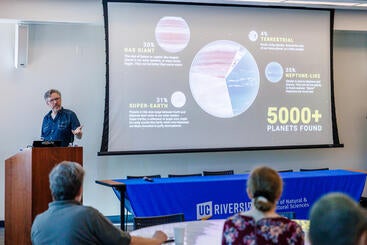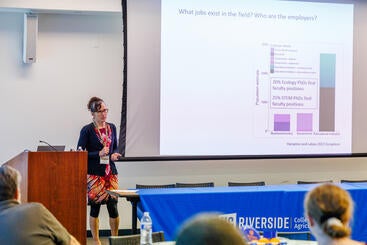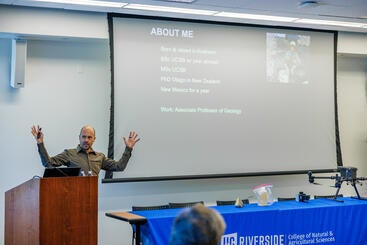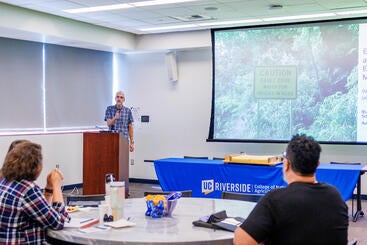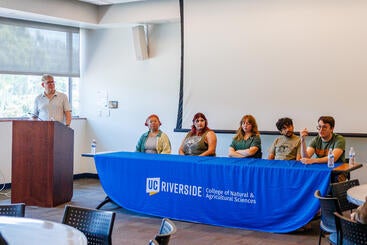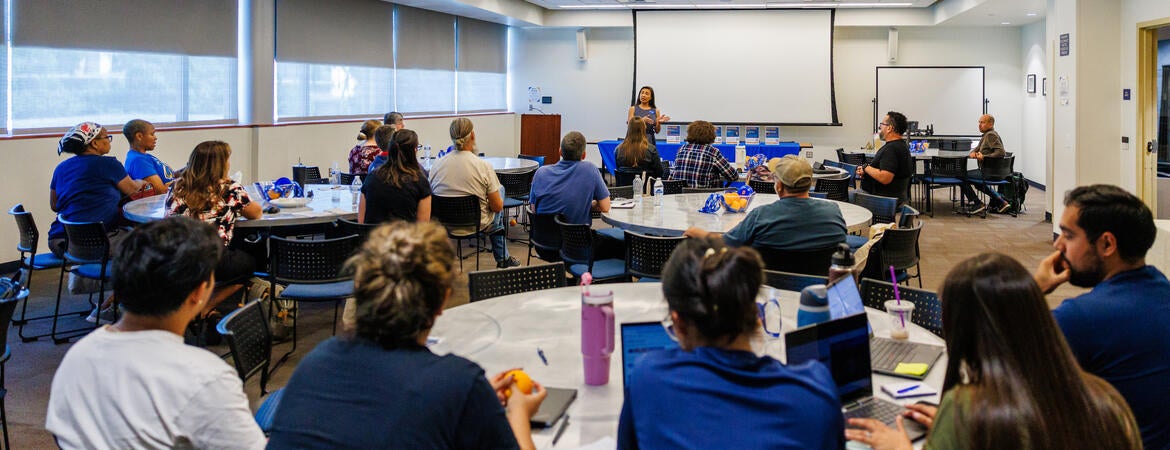
In a day-long symposium on August 6, a panel of researchers from UC Riverside’s (UCR) College of Natural & Agricultural Sciences (CNAS) expounded on the earth and space sciences to an audience of high school and middle school science teachers from the Riverside Unified School District (RUSD). The Earth & Space Sciences Symposium, held on campus, was the first of what is hoped to be many more gatherings that bring together UCR faculty and instructors from local school districts.
In addition to fulfilling the desire of science teachers from RUSD to learn firsthand from experts at UCR in the field of earth and space sciences, organizers saw the inaugural event as a great opportunity for CNAS and UCR to reach out to local science teachers which, next to family and friends, exert a big influence over where their students may go to college.
“Our local science teachers are a great ally to UCR,” said Julia Smith, TK-12 Science Instructional Specialist, and one of the organizers of the Symposium from RUSD along with Heather McDonald, a Teacher on Special Assignment (TOSA). “But it’s also important to note that RUSD teachers have been asking for more earth and space sciences professional development. We put this symposium together to address that specific need. It’s something we’ve been talking about doing for the last couple of years and this year everyone involved was at a point where we could make it happen.”
Along with between 30-35 teacher attendees from RUSD and the lecturing professors, CNAS Dean Peter Atkinson and Stephanie Dingwall, CNAS Divisional Dean of Student Academic Affairs, were on hand to bookend the Symposium with opening and closing remarks.
“You know better than me that we have a tremendous resource in the Inland Empire -- it’s the RUSD and the students they teach,” Dean Atkinson said. “All the students need is the opportunities to be presented to them and to understand and appreciate both what you do and also what we have here at UCR, right in their backyard.”
Dean Atkinson said that his goal over the next five years is to position UCR as the premiere destination for all students in the Inland Empire who wish to pursue a career in science no matter where that might take them. “I know and you know they have the potential to do it, they just need the opportunity,” he told attendees. “We have a broad science college here. It’s unique in the UC system in that it has physical sciences, mathematics, life sciences and agricultural sciences. We do it all! And the students that come here have that opportunity to interact with all these types of scientists no matter what their major may be or what their research project.”
UCR Symposium Speakers
During the course of the Symposium, six outstanding UCR researchers spoke for approximately 50 minutes each on a variety of Earth and Space Science topics.
Stephen Kane, Professor of Planetary Astrophysics at UCR, presented on Planetary Habitability in the Solar System and Beyond. Prof. Kane was a research scientist at the California Institute of Technology and Professor at San Francisco State University, before arriving at UCR in 2017. His studies include planetary habitability, solar system planets and planets around other stars; he’s especially interested in our sister planet Venus.
Throughout the course of his career, Prof. Kane has discovered hundreds of planets orbiting other stars and is a leading expert on the topic of planetary habitability, the habitable zone of planetary systems, and the study of why Venus and Earth underwent divergent evolutions. He has authored several books on the topic of exoplanets and habitability and is a senior science team member for several NASA missions designed to study solar system bodies and search for life in the universe.
Professor of Geophysics at UCR, Abhijit Ghosh, lectured on Earthquake: what, why, and hazards. Prof. Ghosh is currently an associate editor of the Seismological Research Letters published by the Seismological Society of America and he specializes in seismic array techniques, application of AI in earthquake study, high-resolution earthquake imaging, earthquake triggering and physics of earthquake and rock failure.
“The broad goal of my research is to better understand the physics of earthquakes, the processes that control them and their associated hazards by examining a wide spectrum of fault slip across a broad range of spatial and temporal scales,” he said. “Some of my focus areas are seismic array techniques, machine learning, AI and their applications in imaging earthquakes — big and small, slow and fast. In addition, I work on aftershock dynamics, fault structure, induced earthquakes and sustainability.”
Erin Conlisk, Senior Quantitative Ecologist in UCR’s Center for Conservation Biology addressed Conservation Applications Under Global Change. Her work straddles applied conservation and academic research and she’s active in educational outreach; one of her favorite activities is to adapt articles for Earth Science Journal for Kids.
In addition to her research in UCR's Center for Conservation Biology, Dr. Conlisk is also associated with the non-profit Conservation Biology Institute. “My research spans a variety of topics important to conservation in California and beyond,” she said. That research includes vegetation simulations to understand the impacts of wildfire to human and natural communities, data analysis to support waterbird management in the Central Valley of California and designing connectivity networks for iconic wildlife in Southern California.
The principal focus of Associate Professor of Geology at UCR, Nicolas Barth, is to improve our understanding of active faults and the evolution of landscapes. Prof. Barth’s interests span many aspects of geology but are focused on the understanding of active faults and the evolution of landscapes. He uses a multi-disciplinary field-based, lab-supported, collaborative approach to explore far-reaching, broader picture research interests. His research is currently focused on the New Zealand and California plate boundaries.
David Oglesby, Professor of Geophysics in the Department of Earth and Planetary Sciences (EPS) at UCR, focuses on the physics of the earthquake process, with an emphasis on the physical processes taking place during the rapid sliding of the fault. Primarily using computer faulting models, he investigates questions such as what makes some earthquakes large, while others remain small, which factors of the earthquake process lead to the strong ground motion we experience on the Earth’s surface and how to earthquake sources affect the generation of tsunamis.
Prof. Oglesby’s research focuses on the physics of earthquakes using computer modeling techniques and he has a long-standing interest in how the structure of faults, including their bends, branches, offsets, and orientations affect the magnitude, timing, and distribution of fault slip, with implications for the generation of strong ground motion and damaging surface displacement.
Gareth Funning, Professor of Seismology at UCR in the Department of Earth and Planetary Sciences and EPS Lead Faculty Advisor, studies how a variety of natural and anthropogenic processes (including earthquakes, fault creep, landslides and geothermal power production) deform the Earth's surface. Specifically, his research focuses on how we can use measurements of that deformation, from InSAR (a radar remote sensing technique) and GNSS (GPS and other satellite systems that are used for positioning), to learn more about those processes and the properties of faults and the rocks of the Earth's crust and upper mantle.
Joining Professor Funning was a panel of current students and recent graduates from the UCR Earth and Planetary Sciences Department (Isabella Del Toro, Rebecca Leung, Megan McCabe, Kian McElfresh, and Alexandro Vega) who shared their experience as a student, plans for the future, and tips for teachers to help encourage and prepare students interested in earth and spaces sciences.
“I’m hopeful that attendees of the symposium took away a new understanding of current research and that they will learn things they didn’t know before,” said Ms. Smith. “I’m confident that our teachers will bolster new knowledge with what they are teaching in the classroom.
“The other part of the equation,” she added, “is making connections so that the teachers might be able to have UCR faculty visit their classrooms in the future or bring their students to UCR.”
Dean Atkinson told the assembled teachers that at UCR, everyone works together. “That’s the advantage of having all the sciences represented in the college,” he said. “And that’s why there will be more and more of these symposiums in the coming years; it’s a seamless interaction that benefits everyone.”
